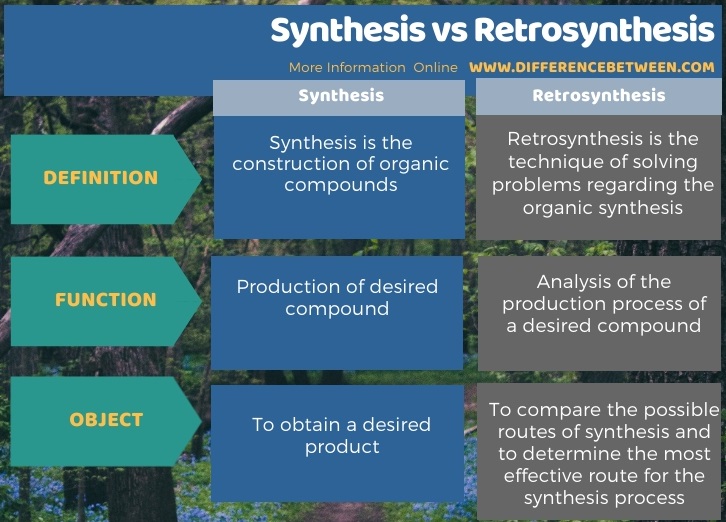Difference Between Synthesis and Retrosynthesis
The key difference between synthesis and retrosynthesis is that synthesis is the construction of organic compounds, whereas retrosynthesis is the technique solving problems regarding organic synthesis.
Although the terms synthesis and retrosynthesis sound similar, they are two different terms that express two different meanings. However, there is a relationship between them as well; retrosynthesis simply explains synthesis. In this article, we are using the term synthesis to explain the specific branch of chemical synthesis which involves organic synthesis. The production of a certain compound may have different possible routes of synthesis and we can determine the suitable route by comparing all the routes using retrosynthesis.
CONTENTS
1. Overview and Key Difference
2. What is Synthesis
3. What is Retrosynthesis
4. Side by Side Comparison – Synthesis vs Retrosynthesis in Tabular Form
5. Summary
What is Synthesis?
Synthesis is the construction of organic compounds. It is a specific branch of chemical synthesis which refers to the organic synthesis. Generally, organic compounds are complex than inorganic compounds. Therefore, the synthesis processes of these organic compounds are also complicated. A few different areas of organic synthesis include total synthesis, semisynthesis, methodology, stereoselective synthesis, etc.

Figure 01: Different Routes for the Synthesis of the Same Product
The term total synthesis refers to the complete synthesis of organic compounds. Here, the starting materials are simple and natural precursors or petrochemical compounds. There are two approaches we can use to obtain a total synthesis: linear synthesis approach and convergent synthesis approach. In a linear synthesis approach, we can use a series of reaction steps, one after another, to synthesize the desired chemical compound. Convergent synthesis approach involves the individual production of separate pieces and combination at the end to obtain the desired product.
What is Retrosynthesis?
Retrosynthesis is the technique of solving problems regarding organic synthesis. Therefore, this is an analysis. In this technique, we transform a target molecule into simple precursor molecules, without considering the reaction or the reagents used during this transformation. Thereafter, we have to examine each precursor molecule using the same method. We have to do this until we reach a simpler, commercially available precursor molecule. Often, a synthesis process has more than one route for the production of the desired product. In that case, retrosynthesis is very useful in identifying these different routes and comparing them to determine the most suitable and effective route.

Figure 02: Application of Synthon
In this technique, there are different terms; we need to know the definitions. Retron refers to the simplest chemical compound that allows the transformation mentioned above. A retrosynthetic tree is a diagram showing all possible routes of synthesis. Synthon is a compound that can assist the transformation, while the target is the desired final product.
What is the Difference Between Synthesis and Retrosynthesis?
Although the terms synthesis and retrosynthesis sound similar, they are two different terms that express two different meanings. The key difference between synthesis and retrosynthesis is that the synthesis is the construction of organic compounds. But, retrosynthesis is the technique solving problems regarding organic synthesis. Therefore, the term synthesis refers to the production of the desired product, while the term retrosynthesis refers to the analyzing of the production process. There can be different possible routes for the production of the same compound. Here, we can use retrosynthesis for the determination of the most suitable and effective route.
Below infographic summarizes the difference between synthesis and retrosynthesis.

Summary – Synthesis vs Retrosynthesis
Although the terms synthesis and retrosynthesis sound similar, they are two different terms that express two different meanings. The key difference between synthesis and retrosynthesis is that synthesis is the construction of organic compounds whereas retrosynthesis is the technique solving problems regarding organic synthesis. There, synthesis means the production process while retrosynthesis means the analysis of the production process. That means; the production of a certain compound may have different possible routes of synthesis and we can determine the suitable route by comparing all the routes using retrosynthesis.
Reference:
1. “9.9 An Introduction to Organic Synthesis.” Chemistry LibreTexts, Libretexts, 5 June 2019, Available here.
2. “Organic Synthesis.” Wikipedia, Wikimedia Foundation, 8 Nov. 2019, Available here.
3. “Retrosynthetic Analysis.” Wikipedia, Wikimedia Foundation, 14 July 2019, Available here.
Image Courtesy:
1. “BHC synthesis of ibuprofen 2” By Me, I modified it – Wikimedia Commons: File:BHC synthesis of ibuprofen.png, (CC0) via Commons Wikimedia
2. “Retrosynthetic analysis of phenylacetic acid” (Public Domain) via Commons Wikimedia
ncG1vNJzZmivp6x7pbXFn5yrnZ6YsqOx07CcnqZemLyue8OinZ%2Bdopq7pLGMm5ytr5Wau26%2F2KeroZ2jnsBurc2dZKudpKe8tMXNrZ%2Beq5mofA%3D%3D